Continuous Automatic Water Change System (CAWC)
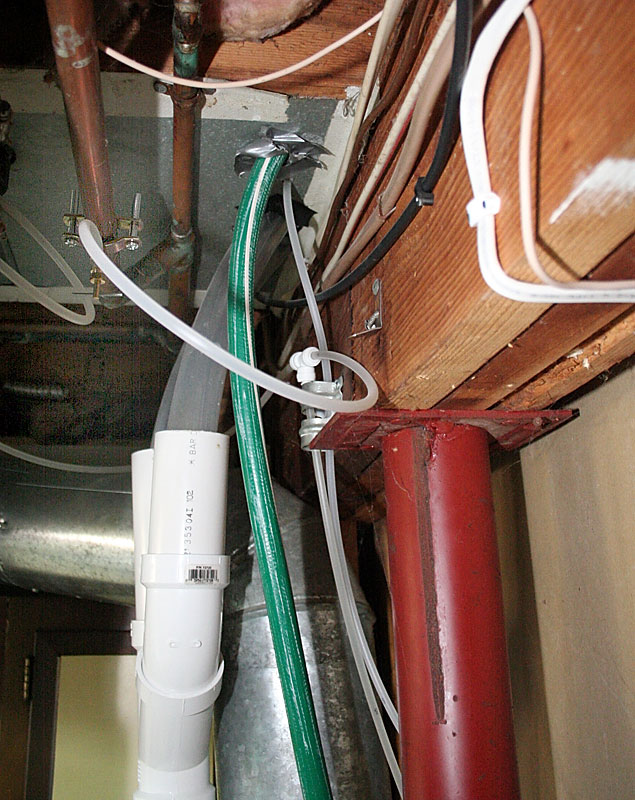 The central part of my CAWC system with a saddle valve on the warm water pipe in the top, left-hand side corner. From here the tubing leads to a T-connection (center) to also allow water from a saddle valve on the cold water pipe (outside of the photo) to come in, and continue to a carbon block filter (below the frame of this photo). From the filter the tubing leads back up again via a heating duct through the ceiling (top, center) and into the cabinet under the tank, where the water drips into the sumps. You can also see two 1" PVC hoses leading into 2" PVC pipe. This is the sump overflow. Last but not least, the green garden hose is used to refill the sumps after major maintenance operations.
The continuous automatic water change system (CAWC) is one of my favorite parts of this tank assembly. The whole setup cost well below $50, and could have been done under $20. How much work it saves me in doing endless water changes is hard to overestimate. Also, I firmly believe that the ever constant water quality and water parameters that this system creates are one of the keys to the excellent health that my Tanganyika cichlids enjoy in this tank.
The CAWC system consists of a simple saddle valve on the house water pipe. Via a carbon block filter this water is transported through 1/4" polyethylene tubing to the sumps, where it drips right into the intake of the pumps. In this way the automatic water change system supplies an estimated 10% of the total system volume (about 30G) of water per day. Any excess water runs via overflows in the sumps into the house drain. In this way, not only the main tank but also the sumps are all the way full all the time. I've set up a similar system for my 125G tank that is not drilled and filtered by a canister filter.
The central part of my CAWC system with a saddle valve on the warm water pipe in the top, left-hand side corner. From here the tubing leads to a T-connection (center) to also allow water from a saddle valve on the cold water pipe (outside of the photo) to come in, and continue to a carbon block filter (below the frame of this photo). From the filter the tubing leads back up again via a heating duct through the ceiling (top, center) and into the cabinet under the tank, where the water drips into the sumps. You can also see two 1" PVC hoses leading into 2" PVC pipe. This is the sump overflow. Last but not least, the green garden hose is used to refill the sumps after major maintenance operations.
The continuous automatic water change system (CAWC) is one of my favorite parts of this tank assembly. The whole setup cost well below $50, and could have been done under $20. How much work it saves me in doing endless water changes is hard to overestimate. Also, I firmly believe that the ever constant water quality and water parameters that this system creates are one of the keys to the excellent health that my Tanganyika cichlids enjoy in this tank.
The CAWC system consists of a simple saddle valve on the house water pipe. Via a carbon block filter this water is transported through 1/4" polyethylene tubing to the sumps, where it drips right into the intake of the pumps. In this way the automatic water change system supplies an estimated 10% of the total system volume (about 30G) of water per day. Any excess water runs via overflows in the sumps into the house drain. In this way, not only the main tank but also the sumps are all the way full all the time. I've set up a similar system for my 125G tank that is not drilled and filtered by a canister filter.
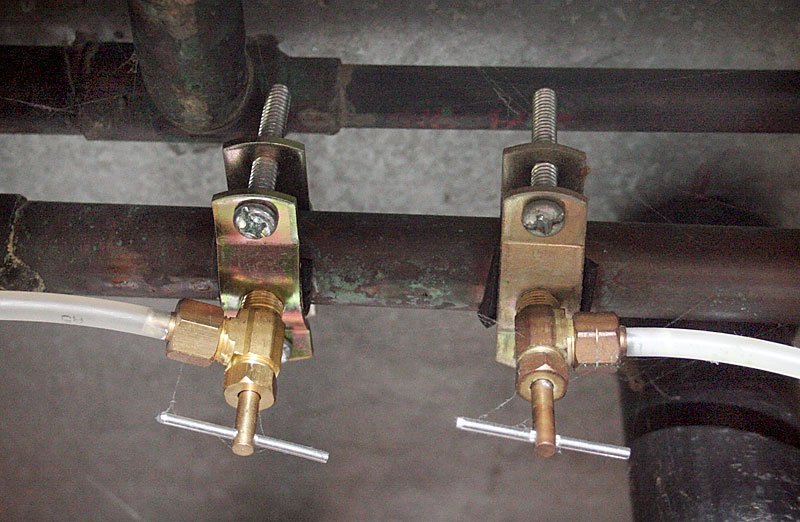 Close-up shop of two saddle valves sitting on the cold water pipe. One is used by the CAWC system, the other one happens to be the one used for the ice-maker and water dispenser of my fridge.
Self-drilling saddle valves like the one I used here are available from any hardware store. A common application is to connect refrigerators with a water and ice dispenser in the door to the water mains. 'Self-drilling' means all you need to install this valve is a screwdriver. You can definitely do this yourself without the help of a plumber. Two clamps attach the valve to any area of straight water pipe you have access to, and the first time you screw the tap down, it automatically drills a hole into the pipe. Screwing it back out will open the valve, screwing it in will close it again. From the valve you can work with polyethylene tubing and corresponding slip fittings (also widely available at hardware stores) to connect the valve to the sump. I am using Watts Polyethylene tubing with an outside diameter if 1/4", and a specified inside diameter of X.170" (whatever that means).
Close-up shop of two saddle valves sitting on the cold water pipe. One is used by the CAWC system, the other one happens to be the one used for the ice-maker and water dispenser of my fridge.
Self-drilling saddle valves like the one I used here are available from any hardware store. A common application is to connect refrigerators with a water and ice dispenser in the door to the water mains. 'Self-drilling' means all you need to install this valve is a screwdriver. You can definitely do this yourself without the help of a plumber. Two clamps attach the valve to any area of straight water pipe you have access to, and the first time you screw the tap down, it automatically drills a hole into the pipe. Screwing it back out will open the valve, screwing it in will close it again. From the valve you can work with polyethylene tubing and corresponding slip fittings (also widely available at hardware stores) to connect the valve to the sump. I am using Watts Polyethylene tubing with an outside diameter if 1/4", and a specified inside diameter of X.170" (whatever that means).
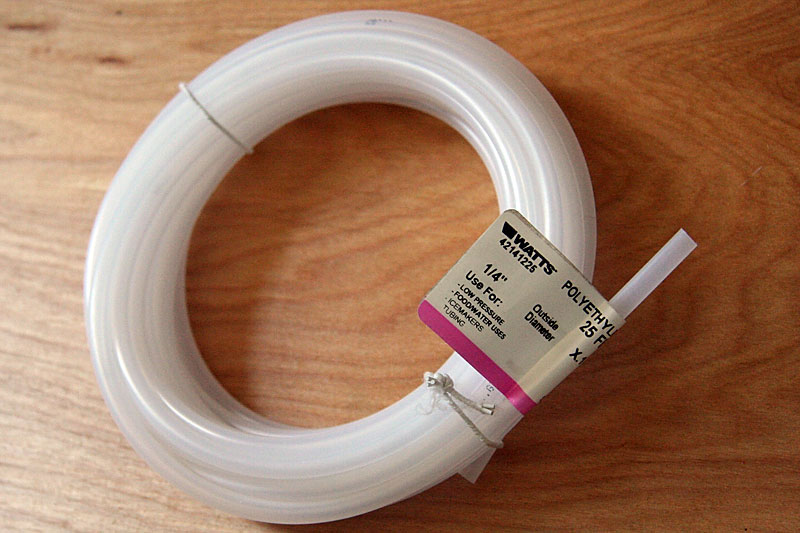 A 25' coil of Watts 1/4" Polyethylene tubing from Home Depot.
I ran the tubing via a carbon block filter though, which ran about $30 at Home Depot and Lowes, with exchange cartridges that are necessary every 6 months or so running under $10. This filter will get rid of lots of undesirable contents of the water, such as heavy metals and even chlorine. For chlorine removal the filter isn't really necessary, because considering the low rate with which the water is added, the chlorine is likely to disproportionate before it can do any harm to the fish. As an aside, the main reason chlorine solutions in water are not stable in the long term is that chlorine undergoes disproportionation, not that it dissipates into the air. Anyhow, it's nice to have piece of mind about the fact that the chlorine is gone from your tank water, and carbon block filters are not expensive. If your water contains chloramines, the filter won't work and if you'd want to use a CAWC system like this, you'd probably be best advised adding dechlorinator by using a dosing pump. They can be expensive, so I am lucky in that my city uses chlorine, not chloramines.
A 25' coil of Watts 1/4" Polyethylene tubing from Home Depot.
I ran the tubing via a carbon block filter though, which ran about $30 at Home Depot and Lowes, with exchange cartridges that are necessary every 6 months or so running under $10. This filter will get rid of lots of undesirable contents of the water, such as heavy metals and even chlorine. For chlorine removal the filter isn't really necessary, because considering the low rate with which the water is added, the chlorine is likely to disproportionate before it can do any harm to the fish. As an aside, the main reason chlorine solutions in water are not stable in the long term is that chlorine undergoes disproportionation, not that it dissipates into the air. Anyhow, it's nice to have piece of mind about the fact that the chlorine is gone from your tank water, and carbon block filters are not expensive. If your water contains chloramines, the filter won't work and if you'd want to use a CAWC system like this, you'd probably be best advised adding dechlorinator by using a dosing pump. They can be expensive, so I am lucky in that my city uses chlorine, not chloramines.
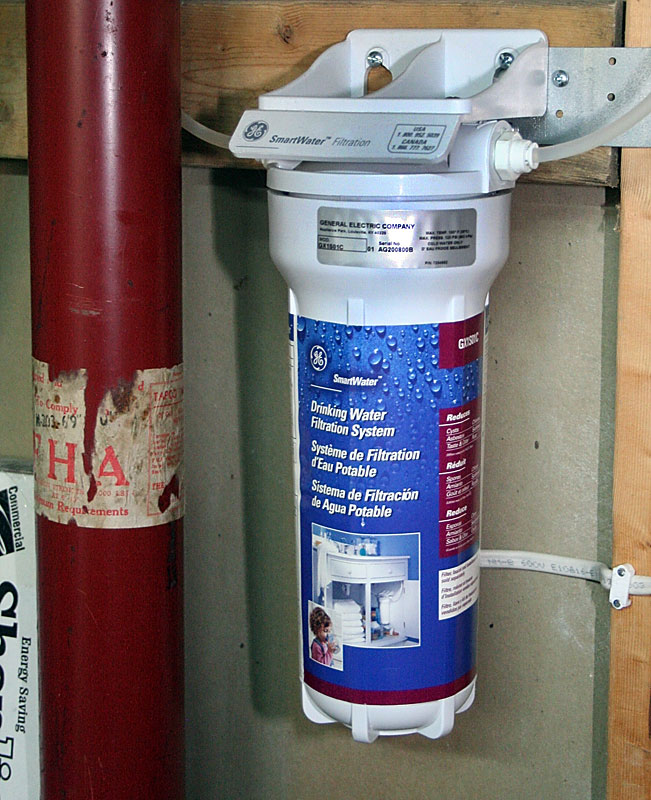 A carbon block filter takes care of chlorine and trace heavy metal contamination in the water.
My tank is situated on the ground floor of my house, and the saddle valve for the CAWC system as well as the carbon block filter are situated in a laundry room in the basement that's right below the tank. From the filter, I ran polyethylene tubing through the ceiling into the cabinet below the tank. A T-connection branches the tubing off into each of the two sumps. The drip rate into the sump is controlled by a small plastic valve on each side. I measured how much water drips into the tank in a short time - 5 min or so - and then extrapolated the daily drip rate.
This water compensates for any evaporation, so that not only the tank, but also both sumps are full at all times. Any excess water leaves the sumps through 1" bulkheads (bulkhead S*S, 1", 1 3/4" hole, SAVKO part# 8837930553) with 1" strainer screens (strainer screen 1" slip SAVKO part# 270570) that act as overflows in the side of the tank. A great source of these kinds of unusual plumbing parts is SAVKO Plastic Pipe & Fittings Inc.. These bulkheads are connected to the house drain by clear 1" PVC hose. The drainage system has far greater capacity than would be required for the CAWC system, which comes in handy if for some reason more water is drained into the sumps; e.g. at a power outage, than they can hold. Instead of flooding the room, the water will simply enter the house drain, and is automatically replenished over time by the CAWC system.
A carbon block filter takes care of chlorine and trace heavy metal contamination in the water.
My tank is situated on the ground floor of my house, and the saddle valve for the CAWC system as well as the carbon block filter are situated in a laundry room in the basement that's right below the tank. From the filter, I ran polyethylene tubing through the ceiling into the cabinet below the tank. A T-connection branches the tubing off into each of the two sumps. The drip rate into the sump is controlled by a small plastic valve on each side. I measured how much water drips into the tank in a short time - 5 min or so - and then extrapolated the daily drip rate.
This water compensates for any evaporation, so that not only the tank, but also both sumps are full at all times. Any excess water leaves the sumps through 1" bulkheads (bulkhead S*S, 1", 1 3/4" hole, SAVKO part# 8837930553) with 1" strainer screens (strainer screen 1" slip SAVKO part# 270570) that act as overflows in the side of the tank. A great source of these kinds of unusual plumbing parts is SAVKO Plastic Pipe & Fittings Inc.. These bulkheads are connected to the house drain by clear 1" PVC hose. The drainage system has far greater capacity than would be required for the CAWC system, which comes in handy if for some reason more water is drained into the sumps; e.g. at a power outage, than they can hold. Instead of flooding the room, the water will simply enter the house drain, and is automatically replenished over time by the CAWC system.
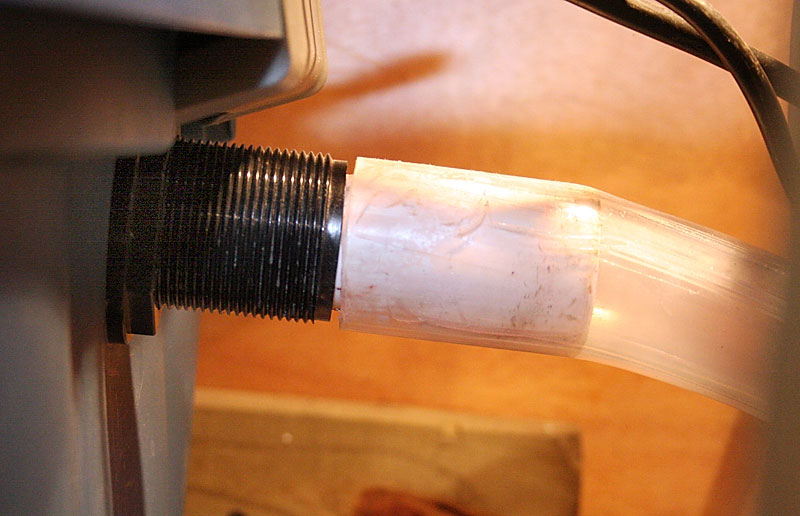 A 1" bulkhead in the sump serves as overflow. The 1" PVC hose has been pushed over a short piece of 1"PVC pipe. This pipe sits firmly in the slip connection of the bulkhead, but can be pulled out for major maintenance operation for which the sump container has to be removed from the cabinet.
I actually installed two saddle valves, one on the hot water pipe and one on the cold water pipe to allow me to use hot water in winter to save on heating costs while being able to use cold water in summer when the tank might otherwise overheat. This was a nice idea but in practice it doesn't work, because the airline tubing lacks insulation and after a few feet the water will be at room temperature no matter if it comes from the hot water pipe or cold water pipe, so a simple connection to the cold water pipe seems like the way to go for all future installations of this type.
Update January 2010
I completely removed the carbon block filter about one year ago, and have not observed any negative effects since. I had never replaced the filter cartridge since setting up the system, meaning a cartridge with a maximum lifetime of about six months ran for about four years. The filter simply wasn't needed in my system.
A 1" bulkhead in the sump serves as overflow. The 1" PVC hose has been pushed over a short piece of 1"PVC pipe. This pipe sits firmly in the slip connection of the bulkhead, but can be pulled out for major maintenance operation for which the sump container has to be removed from the cabinet.
I actually installed two saddle valves, one on the hot water pipe and one on the cold water pipe to allow me to use hot water in winter to save on heating costs while being able to use cold water in summer when the tank might otherwise overheat. This was a nice idea but in practice it doesn't work, because the airline tubing lacks insulation and after a few feet the water will be at room temperature no matter if it comes from the hot water pipe or cold water pipe, so a simple connection to the cold water pipe seems like the way to go for all future installations of this type.
Update January 2010
I completely removed the carbon block filter about one year ago, and have not observed any negative effects since. I had never replaced the filter cartridge since setting up the system, meaning a cartridge with a maximum lifetime of about six months ran for about four years. The filter simply wasn't needed in my system.
3 Responses to “Continuous Automatic Water Change System (CAWC)”
Leave a Reply
You must be logged in to post a comment.

March 26th, 2008 at 6:58 am
[…] components of the system was a continuous automatic water change system. I read about the idea on Frank Meullers site and liked it. The idea being, you have a connection to your mains water supply, through an […]
June 15th, 2008 at 5:11 pm
Hi im interested in making a auto water changer for myself as well.
i have a 270gal tank with 120gal sump. total water volume of 350gal.
I also have a 50gal water holding tank to replenish evaporated water.
If i skip on the carbon filter and do ~5gal water change per day, would the chlorine affect my tank?
i do have a rodi i used for reef tank but didnt plan to use it for african cichlid tank.
June 15th, 2008 at 9:00 pm
If you ad the tap water directly to your system, there is no way to predict with certainty what would happen, because I don’t know how much chlorine – or chloramine is in your tap water. I am am guessing as long as it is chlorine you should be fine. If you ad the water to the holding tank first and let it sit for a day or so before it goes in your system, you will definetely be fine if chlorine is in your water. If chloramine is in your water, you will have to use a dechlorinator no matter what.
I don’t know what a “rodi” is.
HTH
Frank